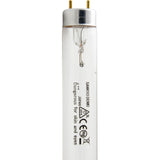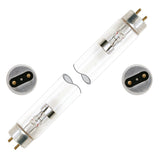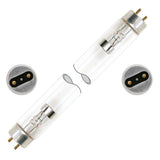What to Know About Mercury in Fluorescent, Ultraviolet, and HID Bulbs
Posted by Dave on for ProLampSales

Reasonable care should be taken in both the handling of broken light bulbs and the disposal of burned out bulbs that contain mercury. For decades, fluorescent and CFL bulbs have been used widely in commercial and residential general lighting settings, but there has been a vast increase in homeowners, businesses, and institutions utilizing ultraviolet bulbs to purify air and sanitize surfaces due to the COVID-19 situation.
Fluorescent tubes, compact fluorescent, UVC germicidal, UVA blacklight, metal halide, and other HID light bulbs all contain mercury compounds. Incandescent, halogen and LED bulbs do not contain mercury. While many HID, CFL, and linear fluorescent bulbs have been replaced by LED, there is no economical alternative to low pressure mercury lamps for germicidal disinfection of air, surfaces, and water. Mercury lamps are still predominant and the installation base has greatly expanded, increasing consumer's concerns with mercury exposure.
Over decades of lighting technology development, manufacturers have produced bulbs that use less and less mercury, making the health risks less severe. However, it is still best to follow government and manufacturer recommendations when a light bulb that contains mercury breaks.
EPA Recommendations
According the Environmental Protection Agency (EPA), take the following steps:
- Have people and pets leave the room.
- Air out the room for 5 to 10 minutes by opening a window.
- Shut off the central forced air furnace or air conditioner.
- Do not use a vacuum to clean up. Instead use cardboard to move the large pieces into a container that can be tightly closed - preferably a glass jar or plastic bag. Use wet paper towels or tape to collect the small pieces and powder. Place everything in the container.
- Wipe the area clean with damp paper towels or sanitary wipes. Place the towels in the same container used for the other debris.
- Put the container outside as soon as the clean-up is finished.
- Wash hands thoroughly. If gloves are used, they should also be disposed of.
- Check with your local government about disposal requirements. In some areas, recycling the broken light bulb is required. In other areas, the material can be placed with the regular garbage.
For a more detailed discussion of how to dispose of broken light bulbs that contain mercury, see the EPA article. This article primarily addresses the use of compact fluorescent lamps in homes, but many of the guidelines apply to any application where mercury-containing lamps are used. And now that more homes are using UVC HVAC systems or tabletop sanitizers, homeowners should be aware of the process for cleaning if a lamp breaks.
Manufacturer Recommendations - Philips
Philips is one of the leading manufacturers of lighting technology, including mercury-free and mercury-containing light sources. Here is what they have to say about their UVC germicidal lamps and breakages.
A lamp breaking is extremely unlikely to have any impact on your health. If a lamp breaks, ventilate the room for 30 minutes and remove the parts, preferably with gloves. Put them in a sealed plastic bag and take it to your local waste facilities for recycling. Do not use a vacuum cleaner.
While less detailed than the EPA recommendations, they are similar. Evacuating and ventilating the room is the first step, followed by clean-up, then recycling or disposing of the broken bulb.
How to dispose of burned out light bulbs containing mercury.
Mercury containing light bulbs are managed under both federal and state regulations. The laws apply to both consumers and businesses. Regulations vary from state to state. Some states have regulations that are more stringent than those of the federal government. Check with your state and local governments to learn what to do.
Some fluorescent and HID light bulbs are manufactured with lower levels of mercury. In a few states they can legally be disposed of with regular garbage, if they pass a toxicity test known as TCLP. This can be a significant savings for schools and businesses that need to dispose of large numbers of bulbs each year.
Reducing Risk of Breakage
When glass tubes break, they can shatter into multiple large, small, and microscopic parts. To address this shattering of the glass, manufacturers have come up with a few ways to either prevent the breakage or at least contain the parts. Tube guards and shatterproof coating are the two most common protective measures.
Tube guards fit over linear fluorescent lamps. They can be either clear or colored. The clear ones provide simple protection, containing glass fragments if the lamp happens to shatter. It would not prevent the lamp from shattering if enough force is applied, but can make clean-up easier. Tube guards are relatively inexpensive, but they apply mostly to linear fluorescent bulbs.
Shatterproof coating is a film applied to fluorescent, CFL, HID, or ultraviolet bulbs. It does not result in any reduction in light or UV radiation output, although it can dramatically add to the cost of bulbs. The film is heat-shrinked onto the lamp, and, if the bulb is broken, it will bend but not shatter. This can entirely prevent a glass bulb from fragmenting. Again, the main drawback of this is the high cost of applying the film to light bulbs.
Quartz sleeves are often used with ultraviolet water purification equipment. They are somewhat protective of the glass bulb, but if the quartz sleeve shatters, the lamp is also likely to break and shatter. What quartz sleeves help with is protecting the electrical components and connections of the UVC bulb from getting wet.
- Posted in Environment, Fluorescent, HID & Metal Halide, Ultraviolet Light
Featured Products (View All)
0 Comments




